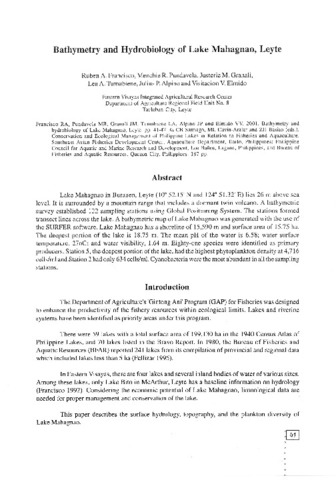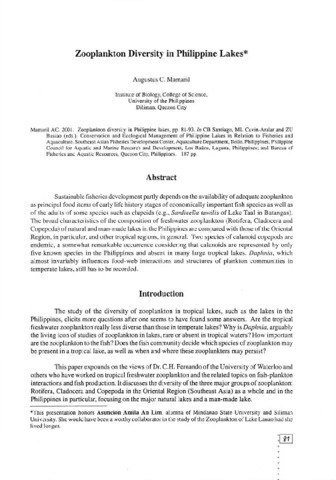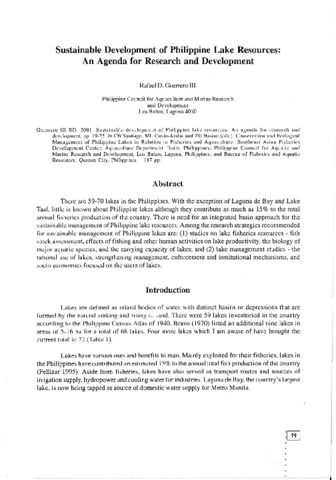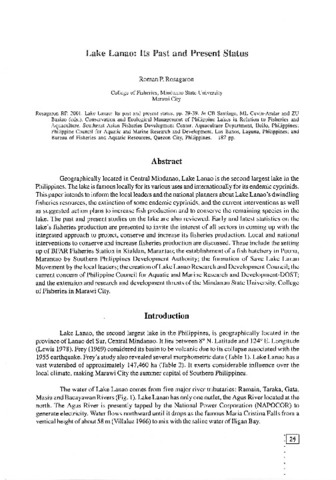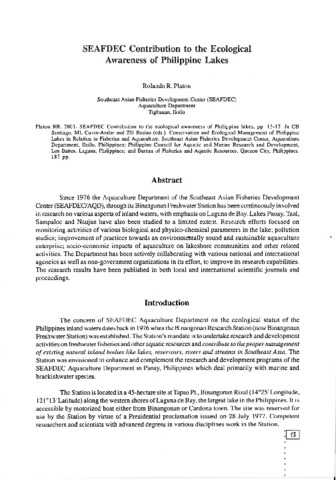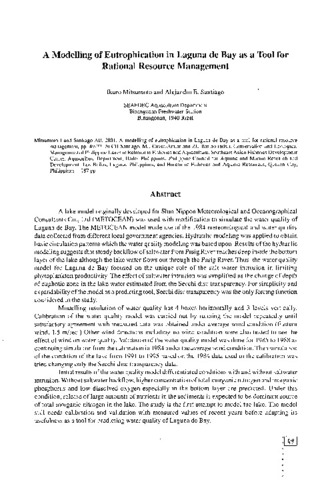Conservation and Ecological Management of Philippine Lakes in Relation to Fisheries and Aquaculture: Recent submissions
Now showing items 21-27 of 27
-
Bathymetry and hydrobiology of Lake Mahagnao, Leyte
(Aquaculture Department, Southeast Asian Fisheries Development Center; Philippine Council for Aquatic and Marine Research and Development (PCAMRD), Department of Science and Technology; Bureau of Fisheries and Aquatic Resources, 2001)Lake Mahagnao in Burauen, Leyte (10° 52.15' N and 124° 51.32' E) lies 26 m above sea level. It is surrounded by a mountain range that includes a dormant twin volcano. A bathymetric survey established 122 sampling stations ... -
Zooplankton diversity in Philippine Lakes
(Aquaculture Department, Southeast Asian Fisheries Development Center; Philippine Council for Aquatic and Marine Research and Development (PCAMRD), Department of Science and Technology; Bureau of Fisheries and Aquatic Resources, 2001)Sustainable fisheries development partly depends on the availability of adequate zooplankton as principal food items of early life history stages of economically important fish species as well as of the adults of some ... -
Aquaculture practices and their impact on Philippine Lakes
(Aquaculture Department, Southeast Asian Fisheries Development Center; Philippine Council for Aquatic and Marine Research and Development (PCAMRD), Department of Science and Technology; Bureau of Fisheries and Aquatic Resources, 2001)The rapid progress and development in the aquaculture sector during the past years has made an important contribution to the overall fish production in the Philippines. In 1996, 35.4% of the total fish production or 980,857 ... -
Sustainable development of Philippine lake resources: An agenda for research and development
(Aquaculture Department, Southeast Asian Fisheries Development Center; Philippine Council for Aquatic and Marine Research and Development (PCAMRD), Department of Science and Technology; Bureau of Fisheries and Aquatic Resources, 2001)There are 59-70 lakes in the Philippines. With the exception of Laguna de Bay and Lake Taal, little is known about Philippine lakes although they contribute as much as 15% to the total annual fisheries production of the ... -
Lake Lanao: Its past and present status
(Aquaculture Department, Southeast Asian Fisheries Development Center; Philippine Council for Aquatic and Marine Research and Development (PCAMRD), Department of Science and Technology; Bureau of Fisheries and Aquatic Resources, 2001)Geographically located in Central Mindanao, Lake Lanao is the second largest lake in the Philippines. The lake is famous locally for its various uses and internationally for its endemic cyprinids. This paper intends to ... -
SEAFDEC contribution to the ecological awareness of Philippine Lakes
(Aquaculture Department, Southeast Asian Fisheries Development Center; Philippine Council for Aquatic and Marine Research and Development (PCAMRD), Department of Science and Technology; Bureau of Fisheries and Aquatic Resources, 2001)Since 1976 the Aquaculture Department of the Southeast Asian Fisheries Development Center (SEAFDEC/AQD), through its Binangonan Freshwater Station has been continuously involved in research on various aspects of inland ... -
A modelling of eutrophication in Laguna de Bay as a tool for rational resources management
(Aquaculture Department, Southeast Asian Fisheries Development Center; Philippine Council for Aquatic and Marine Research and Development (PCAMRD), Department of Science and Technology; Bureau of Fisheries and Aquatic Resources, 2001)A lake model originally developed for Shin-Nippon Meteorological and Oceanographical Consultants Co., Ltd (METOCEAN) was used with modification to simulate the water quality of Laguna de Bay. The METOCEAN model made use ...

